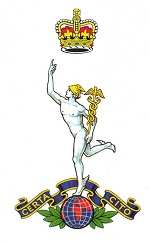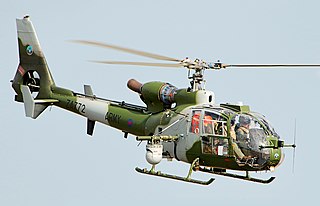
The Falkland Islands are a British overseas territory and, as such, rely on the UK for the guarantee of their security. The other UK territories in the South Atlantic, South Georgia and the South Sandwich Islands, fall under the protection of British Forces South Atlantic Islands (BFSAI), formerly known as British Forces Falkland Islands (BFFI), which includes commitments from the British Army, Royal Air Force and Royal Navy. They are headed by the Commander of the British Forces South Atlantic Islands (CBFSAI).
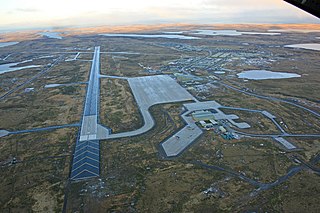
RAF Mount Pleasant is a Royal Air Force station in the British Overseas Territory of the Falkland Islands. The airfield goes by the motto of "Defend the right" and is part of the British Forces South Atlantic Islands (BFSAI). Home to between 1,000 and 2,000 British military personnel, it is located about 33 miles (53 km) southwest of Stanley, the capital of the Falklands—on the island of East Falkland. The world's longest corridor, half a mile (800 m) long, links the barracks, messes and recreational and welfare areas of the station, and was nicknamed the "Death Star Corridor" by personnel.

HMS Cardiff was a British Type 42 destroyer and the third ship of the Royal Navy to be named in honour of the Welsh capital city of Cardiff.

HMS Intrepid (L11) was one of two Fearless-class amphibious warfare ships of the Royal Navy. A Landing Platform Dock (LPD), she served from 1967 until 1999. Based in HM Naval Base, Devonport, Plymouth, Devon and HM Naval Base Portsmouth, she saw service around the world over her 32-year life.
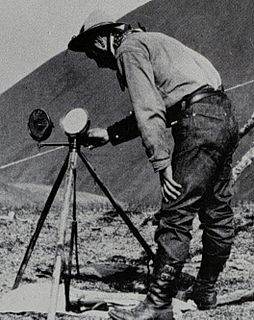
A heliograph is a wireless telegraph that signals by flashes of sunlight reflected by a mirror. The flashes are produced by momentarily pivoting the mirror, or by interrupting the beam with a shutter. The heliograph was a simple but effective instrument for instantaneous optical communication over long distances during the late 19th and early 20th century. Its main uses were military, survey and forest protection work. Heliographs were standard issue in the British and Australian armies until the 1960s, and were used by the Pakistani army as late as 1975.
This is a list of British ground forces in the Falklands War. For a list of ground forces from Argentina, see Argentine ground forces in the Falklands War
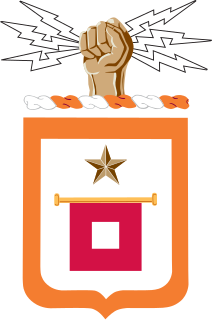
The United States Army Signal Corps (USASC) is a division of the Department of the Army that creates and manages communications and information systems for the command and control of combined arms forces. It was established in 1860, the brainchild of Major Albert J. Myer, and had an important role in the American Civil War. Over its history, it had the initial responsibility for portfolios and new technologies that were eventually transferred to other U.S. government entities. Such responsibilities included military intelligence, weather forecasting, and aviation.

The City of London Yeomanry was a yeomanry regiment of the British Territorial Army, formed in 1901. It amalgamated with the Inns of Court Regiment to form the Inns of Court & City Yeomanry in 1961. The lineage is maintained by 68 Signal Squadron, part of 71 (Yeomanry) Signal Regiment.

The 5th Infantry Brigade was a regular infantry brigade of the British Army that was in existence since before the First World War, except for a short break in the late 1970s, until amalgamating with 24th Airmobile Brigade, in 1999, to form 16 Air Assault Brigade.

The Signal Corps in the American Civil War comprised two organizations: the U.S. Army Signal Corps, which began with the appointment of Major Albert J. Myer as its first signal officer just before the war and remains an entity to this day, and the Confederate States Army Signal Corps, a much smaller group of officers and men, using similar organizations and techniques as their Union opponents. Both accomplished tactical and strategic communications for the warring armies, including electromagnetic telegraphy and aerial telegraphy. Although both services had an implicit mission of battlefield observation, intelligence gathering, and artillery fire direction from their elevated signal stations, the Confederate Signal Corps also included an explicit espionage function.
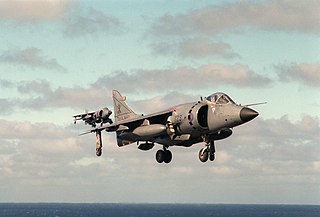
This is a list of the units, aircraft and casualties of the British air services in the Falklands War. The numbers in bold are the number of aircraft used in the war, the numbers in brackets are the number of lost aircraft. For a list of air forces from Argentina, see Argentine air forces in the Falklands War.
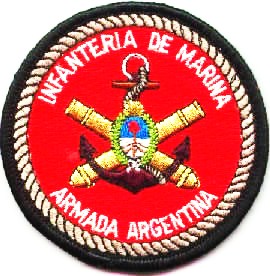
The Naval Infantry Command, also known as the Naval Infantry of the Navy of the Argentine Republic and generally referred to in English as the Argentine marines are the amphibious warfare branch of the Argentine Navy and one of its four operational commands.

656 Squadron AAC is a squadron of the British Army's Army Air Corps. It was chosen as one of the AAC new Apache Squadrons and in April 2004 started its conversion to role. The first phase of this completed in October 2004. The Squadron was the first operational Apache Squadron in the Army Air Corps and was awarded fully operational status along with the remainder of 9 Regiment AAC in June 2005. It is under 4 Regiment AAC as of 2007.

On 6 June 1982, during the Falklands War, the British Royal Navy Type 42 destroyer HMS Cardiff engaged and destroyed a British Army Gazelle helicopter, serial number XX377, in a friendly fire incident, killing all four occupants. Cardiff, on the lookout for aircraft flying supplies to the Argentine forces occupying the Falkland Islands, had misidentified the helicopter as an enemy C-130 Hercules. Although the helicopter's loss was initially blamed on enemy action, a subsequent inquiry found Cardiff's missile to be the cause.

Signal Corps Radios were U.S. Army military communications components that comprised "sets". Under the Army Nomenclature System, the abbreviation SCR initially designated "Set, Complete Radio", but was later misinterpreted as "Signal Corps Radio."

The Assault on Mount Kent was an engagement during the Falklands War between British and Argentine forces.
Indian Army Corps of Signals is a corps and an arm of the Indian Army, which handles its military communications. It was formed on 15 February 1911 as a separate entity under Lieutenant Colonel S H Powell, and went on to make important contributions to World War I and World War II. The corps celebrated its 100-year anniversary of its raising on 15 February 2010.

The Pakistan Army Corps of Signals (Urdu: ﺁرمى سگنل كور; Army Signal Core, is an active combatant military administrative staff corps and a major intelligence and science and technology command of Pakistan Army. The corps core objectives includes the research and development, tests, and manage the military communications and information systems support for the command and control of combined arms forces.
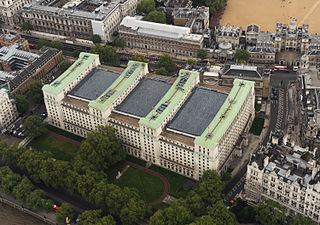
At the end of the Cold War in 1989 the British Armed Forces structure was as follows:

